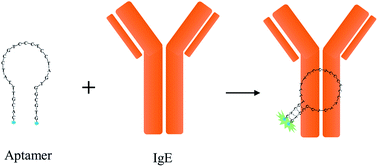Rapid fluorescence detection of immunoglobulin E using an aptamer switch based on a binding-induced pyrene excimer†
Abstract
Immunoglobulin E (IgE) is an important immunoglobulin related to allergic reactions and some diseases such as atopic dermatitis, allergic asthma, etc. Sensitive and rapid detection of IgE is desired for disease diagnosis and therapeutics. Taking advantage of a binding-induced pyrene excimer, we developed a sensitive fluorescent aptamer switch for IgE sensing by using a pyrene-labeled aptamer. The aptamer having four base pairs at the stem was labeled with a single pyrene molecule at the 3′ end and 5' end and used as an affinity probe. The binding of IgE brought the pyrene moiety at each terminal of the aptamer into proximity, generating an excimer and showing a distinct fluorescence peak. The measurement of the fluorescence peak of the excimer allowed the sensitive detection of IgE. We optimized the experimental conditions such as temperature, incubation time, and metal cations. The detection limit for IgE was about 1.6 nM. This assay displayed good specificity and allowed for the detection of IgE spiked in a diluted human serum sample. This fluorescent aptamer sensor has potential for its application in rapid sensing of IgE.



 Please wait while we load your content...
Please wait while we load your content...